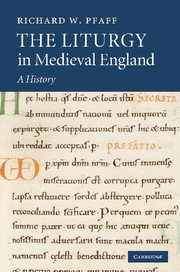Book contents
- Frontmatter
- Contents
- Preface
- Sigla and editorial conventions
- Bibliographical abbreviations
- Nicknames for manuscripts frequently referred to
- 1 Introduction
- Excursus: on sources
- 2 Early Anglo-Saxon England: a partly traceable story
- Excursus: on the terms Gregorian and Gelasian as used here
- 3 Later Anglo-Saxon: liturgy for England
- 4 The Norman Conquest: cross fertilizations
- Excursus: on method in the comparison of liturgical texts
- 5 Monastic liturgy, 1100–1215
- Excursus: on ascription of liturgical books to specific churches
- 6 Benedictine liturgy after 1215
- 7 Other monastic orders
- 8 The non-monastic religious orders: canons regular
- 9 The non-monastic religious orders: friars
- Excursus: on liturgical books from female religious houses
- 10 Old Sarum: the beginnings of Sarum Use
- 11 New Sarum and the spread of Sarum Use
- 12 Exeter: the fullness of secular liturgy
- 13 Southern England: final Sarum Use
- 14 Regional Uses and local variety
- 15 Towards the end of the story
- Index of Manuscripts
- Index of Saints
- General Index
8 - The non-monastic religious orders: canons regular
Published online by Cambridge University Press: 20 March 2010
- Frontmatter
- Contents
- Preface
- Sigla and editorial conventions
- Bibliographical abbreviations
- Nicknames for manuscripts frequently referred to
- 1 Introduction
- Excursus: on sources
- 2 Early Anglo-Saxon England: a partly traceable story
- Excursus: on the terms Gregorian and Gelasian as used here
- 3 Later Anglo-Saxon: liturgy for England
- 4 The Norman Conquest: cross fertilizations
- Excursus: on method in the comparison of liturgical texts
- 5 Monastic liturgy, 1100–1215
- Excursus: on ascription of liturgical books to specific churches
- 6 Benedictine liturgy after 1215
- 7 Other monastic orders
- 8 The non-monastic religious orders: canons regular
- 9 The non-monastic religious orders: friars
- Excursus: on liturgical books from female religious houses
- 10 Old Sarum: the beginnings of Sarum Use
- 11 New Sarum and the spread of Sarum Use
- 12 Exeter: the fullness of secular liturgy
- 13 Southern England: final Sarum Use
- 14 Regional Uses and local variety
- 15 Towards the end of the story
- Index of Manuscripts
- Index of Saints
- General Index
Summary
Augustinian canons
The amount of attention it will be necessary to devote to the canons regular may seem surprising, given the prevailing assumption that they normally used the liturgies of the diocese in which a given house was located. If this turns out to be generally the case, it must not prevent us from looking into the ways in which this very large, if initially somewhat amorphous, group of religious have influenced the story we are trying to trace.
The factors of size and amorphousness are interrelated. As Sir Richard Southern has demonstrated, people of a level under the great landed aristocracy could afford to endow foundations at the middling level that seems to have sufficed for Augustinians (in contrast to Benedictines); the result was that, in his words, “living under a modest Rule the canons performed modest services for men of moderate means and moderate needs.” The consequence in liturgical terms is that their worship is likely to have been in many respects very close to that of ordinary parish churches, with the added factor of participation by a regular religious community. Where this factor was substantial, as in the greater houses like Cirencester and Guisborough, the regular, community aspect would probably have predominated; where it was slight, as with the great number of smaller Augustinian houses, there must often have been close approximation to parochial worship. Indeed, we shall see that some key liturgical manuscripts have reasonably been ascribed to both regular houses and parish churches.
- Type
- Chapter
- Information
- The Liturgy in Medieval EnglandA History, pp. 272 - 310Publisher: Cambridge University PressPrint publication year: 2009



